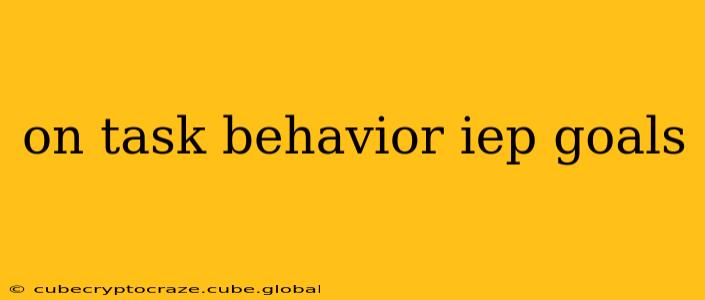Creating effective IEP goals for on-task behavior requires a nuanced understanding of the student's specific challenges and strengths. This guide provides a framework for developing measurable, achievable, and relevant goals, encompassing various strategies and considerations. We'll address common questions and offer examples to help you craft impactful goals that promote academic success.
What are On-Task Behavior IEP Goals?
On-task behavior IEP goals aim to increase a student's engagement and focus during academic activities. These goals address issues like inattention, distractibility, impulsivity, and off-task behaviors that hinder learning. They are crucial for students with ADHD, learning disabilities, or other conditions impacting focus and attention. Effective goals specify the targeted behavior, the desired level of improvement, and the conditions under which the behavior will be observed.
How to Write Effective On-Task Behavior IEP Goals
Effective on-task behavior IEP goals follow the SMART criteria:
- Specific: Clearly define the expected behavior. Avoid vague terms like "improve focus." Instead, use observable and measurable actions.
- Measurable: Establish a clear way to track progress. This might involve percentage of time on-task, number of off-task incidents, or completion of assigned tasks.
- Achievable: Set realistic goals based on the student's current abilities and progress. Start with small, attainable steps and gradually increase expectations.
- Relevant: Ensure the goals align with the student's individual needs and educational program. The goals should directly support academic success.
- Time-Bound: Specify a timeframe for achieving the goal (e.g., by the end of the marking period, by the end of the year).
What Strategies Can Be Included in On-Task Behavior IEP Goals?
Several strategies can be incorporated into IEP goals to address on-task behavior. These strategies should be tailored to the individual student's needs and learning style. Examples include:
- Self-Monitoring: The student tracks their own on-task behavior using a checklist, timer, or other tools.
- Positive Reinforcement: Rewards are given for on-task behavior, such as praise, privileges, or tangible rewards.
- Environmental Modifications: Adjusting the classroom setting to minimize distractions, such as preferred seating, noise reduction strategies, or visual aids.
- Organizational Strategies: Implementing strategies like planners, visual schedules, or task breakdown to improve organization and reduce anxiety.
- Instructional Modifications: Adapting teaching methods, materials, or pacing to better engage the student.
- Behavioral Interventions: Implementing specific techniques to address challenging behaviors, such as prompting, redirection, or consequence systems.
Example On-Task Behavior IEP Goals
Here are examples of well-written on-task behavior IEP goals, demonstrating the application of the SMART criteria and various strategies:
Example 1 (Focusing on duration):
- Goal: Given a 30-minute independent work period, [Student's Name] will remain on-task for 20 minutes, as measured by teacher observation, for 80% of the sessions over four consecutive weeks. Strategy: Use a visual timer and positive reinforcement.
Example 2 (Focusing on number of off-task behaviors):
- Goal: During a 45-minute math class, [Student's Name] will exhibit no more than 2 instances of off-task behavior (defined as getting out of seat, talking without permission, or engaging in non-math related activities) per session, as documented by the teacher, for 80% of the sessions during a four-week period. Strategy: Use a pre-arranged signal (e.g., a gentle touch on the shoulder) to redirect the student back to the task.
Example 3 (Incorporating self-monitoring):
- Goal: [Student's Name] will accurately self-monitor their on-task behavior during a 60-minute language arts class using a self-monitoring checklist, achieving at least 90% accuracy on at least four out of five days a week, for four consecutive weeks. Strategy: Use a simple checklist and provide immediate feedback.
How are On-Task Behavior IEP Goals Measured?
Progress towards on-task behavior IEP goals is typically measured through direct observation and data collection. Teachers may use various methods, including:
- Frequency counts: Recording the number of times a specific behavior occurs.
- Duration recording: Measuring the length of time a behavior lasts.
- Interval recording: Observing the student at regular intervals and recording whether the target behavior is occurring.
- Anecdotal notes: Writing down detailed descriptions of the student's behavior in specific situations.
What if My Child Isn't Making Progress Towards Their On-Task Behavior IEP Goals?
If your child isn't making progress, it's crucial to discuss it with the IEP team. This may involve reviewing the goal's specificity, adjusting the strategies, or implementing alternative interventions. Regular monitoring and adjustments are key to ensuring the IEP's effectiveness.
This comprehensive guide offers a framework for creating effective on-task behavior IEP goals. Remember, collaboration between parents, educators, and the student is essential for success. By setting achievable goals and implementing appropriate strategies, you can help students develop the focus and attention skills necessary for academic success.
